The American Dream Is Not a One-size-fits-all Idea
There have been many caricatures of the American Dream. Some people associate it with owning a house or the next new car, like we’ve seen in many advertisements. These types of ads are “selling” a vision of the American Dream that is more commercial and geared towards material endeavors. But even though ads are meant to persuade and have a specific commercial goal in mind, we need a new ad campaign for a more diverse but at the same time unified vision of the American Dream and what it means for regular people.
As I discussed in a couple of new videos on What Does the American Dream Mean to You?, some people associate the American Dream with owning a house with a white picket fence, or think of it as a great Gatsby caricature of fame and wealth. In the media, when people are asked why they haven’t achieved the American Dream, their response is usually about not making ends meet or not being able to buy a house. And there is a sort of monolithic belief that these ideas are what represent achieving the American Dream—a one-size-fits-all concept. But this one-size-fits-all idea and the pessimism it’s breeding cannot be further from the truth when discussing the American Dream.
The beauty of the American Dream is precisely that it’s not a one-size-fits-all idea. It is a very diverse ethos that has meant millions of different things to millions of different Americans. It now means 330 million different dreams, one for each American. The definition I discussed in previous posts (coming from James Truslow Adams) is about pursuing a better, richer, and fuller life regardless of where you started or who your parents are.
Those three elements of better, richer, and fuller can mean many different things to people. A better life can mean greater life expectancy through better healthcare solutions as we see through medical advancements in many fields like cancer treatment. More technology and projects that make our lives easier and remove barriers to flourishing, such as advancements in AI, can also provide improvements in living standards. A better life can mean moving to places where people have more opportunities. It can be about the pursuit of hobbies as meaningful entrepreneurial endeavors.
Richer can certainly be about having a better financial future, having more wealth. But I would contend that richer futures are not about the pursuit of wealth for the sake of it but more about using that wealth to have more opportunities in life, including being able to support families, have a decent retirement, and overall have a good quality of life. “Richer” can refer to entrepreneurs pursuing wealth creation that improves society through providing more job opportunities and paths to flourishing for many people. Not that there’s anything wrong with wealth and riches that entrepreneurs and millionaires create, but it’s not the main motivator.
Most successful entrepreneurs are interested in solving a problem or providing a good/service that people want. And they end up pursuing their entrepreneurial vision more for the meaning and purpose it brings to them than the wealth it may later provide.
But having a richer life can also mean that through hard work and perseverance the children of immigrants can become more successful than would have ever been possible for their parents in their original countries, and helping their own children achieve even more education and success.
The pursuit of a more fulfilled life is one of the most quintessential aspects of the American Dream. Dreaming and seeking meaning in life is what motivated the first settlers to come to America and the Founding Fathers to pursue American independence. It’s what people do who are always seeking to improve in their craft and who aspire to make a difference in their professions like Simone Biles, Taylor Swift, Elon Musk, Jeff Bezos, or even Jimmy Donaldson, aka Mr. Beast. The list can go on and on. And outside of entrepreneurs, artists, or athletes, the pursuit of a fuller life is embedded in the story of America in people like Frederick Douglass and Martin Luther King Jr. who made it their life’s mission to achieve equality for all and cash in on the promise of the American Dream set out in the Declaration of Independence.
Even more so it can be seen in stories of people helping others in local communities. One of my favorite examples of this was Mike Rowe’s show Returning the Favor that portrayed the American Dream in all of its beauty, with people recognizing community leaders who have selflessly put others before themselves, pursuing their dreams while helping others achieve theirs. And last but not least, a fuller life, like we see in our data below, can mean a good family life, which is not a simple task or a lowly endeavor; it is what keeps our society thriving and flourishing and Is truly the backbone of the American Dream.
At the same time, all three of these areas (better, richer, and fuller) are interrelated. In many cases people are pursuing a better, richer, and fuller life all at once. So, this exercise is not about making a strict distinction or boxing people into these different categories, but it shows the heterogeneity and diversity of the American Dream. And ultimately, it shows the beautiful nature of what the American Dream can represent in all human complexity when all of these areas intersect.
What does the American Dream mean to people?
In a 2023 survey my organization did on the American Dream, we asked people across the 50 states what their American Dreams were. You can see the answers for each state by clicking on the maps on this American Dream Survey page.
When it comes to specific questions, we also asked people to describe how essential specific things are for their pursuit of the American Dream. This table from our report in 2023 shows what people value more:
As you can see, it’s about more than wealth or owning a house. Do we all want a house or to have a lot of money? Probably, but does that inspire us and our dreams? Only half of Americans say that owning a house is essential to the American Dream, and only 14% say becoming wealthy is essential. What do 8 in 10 Americans say is very essential? Having freedom of choice in how to live and having a good family life. Both of those are things that I highlighted above and that could qualify as the pursuit of a better and more fulfilling life according to the James Truslow Adams definition. Retiring comfortably could be about becoming richer. But again, wealth for the sake of it is not a driving force behind the American Dream as we see in those answers.
Zeroing in on what people value as essential, it is significant that consistently over the last four years of the survey people have said:
Even if it remains an important feature of the American Dream, owning a house and being rich is an incomplete and even misleading caricature. Living your dreams and charting your own fulfilling path should be the focus. Being an entrepreneur of your own life by pursuing what is a better, richer, and fuller life to you is what the American Dream is all about. It is bringing your aims and aspirations to fruition. Even if you don’t achieve your American Dream right away, striving for it and having that goal and aspiration in front of you can still make your life one hell of a meaningful ride.
Living the Dream,
Gonzalo






